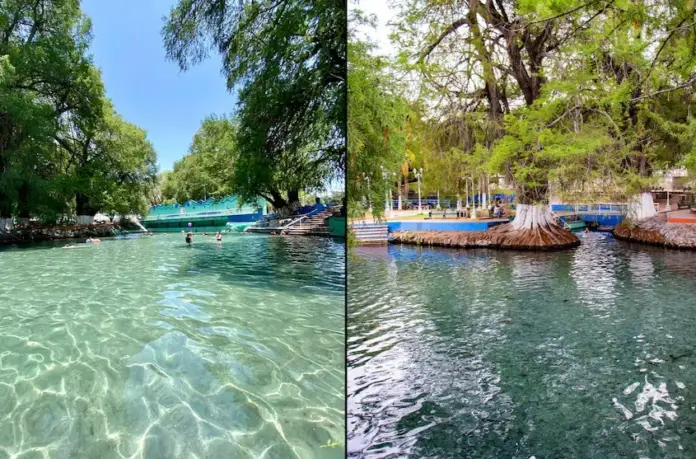In the southeast of the state of Guanajuato, within the municipality of Tarandacuao, lies a crystal-clear spring known as Ojo de Agua, a place that combines natural beauty, history, and cultural traditions.
This site, which is part of the Lerma-Chapala hydrological region, has become an ideal destination for those looking to enjoy recreational and adventure activities, such as rafting, or simply relax in a natural setting.
According to the Guanajuato government, this area is especially popular during the Easter holidays, when visitors from various locations come to cool off in its turquoise waters.
A beautiful natural setting
The landscape of Ojo de Agua is embellished by the presence of majestic ahuehuete trees, trees that have grown for years thanks to the water that flows from the Lerma River to this region.
This setting is not only a refuge for those seeking a peaceful retreat, but also a perfect place for activities such as hiking, swimming, and enjoying a day outdoors under the shade of these ancient trees.
In addition to its main attraction, the spring, Ojo de Agua offers a variety of facilities for visitors to enjoy, such as gardens, palapas, showers, barbecue grills, and areas designed for socializing with family or friends.
Access to the site is affordable: 30 pesos for adults and 20 pesos for children. These fees contribute to the maintenance of this important natural resource that supplies water to the nearby communities.
The municipality of Tarandacuao, whose name has been interpreted as “place where water enters,” is surrounded by territorial boundaries that include Jerécuaro to the north and east, the state of Michoacán to the south, and Acámbaro to the west.
However, according to the Guanajuato government, this definition lacks documentary support and appears to have become popular in the mid-20th century, when historical data on the municipalities began to be collected.
Despite this, Tarandacuao’s relationship with water is undeniable, whether through the Lerma River or springs like Ojo de Agua, which have been fundamental to life in the region since pre-Hispanic times.
Indigenous History and Resistance in Tarandacuao
The history of Tarandacuao is marked by the resistance of Indigenous communities to Spanish colonization. During the early years of the colony, Indigenous peoples’ lands were recognized and protected by the colonial authorities, who ordered that concessions to Spanish settlers not affect Native American lands.
However, these provisions were frequently ignored, leading to conflicts over access to resources such as water and farmland.
An example of this resistance dates back to 1614, when Jusepe de Celi, representing the inhabitants of the town of Santiago Tarandacuao, petitioned the viceroy of New Spain to intervene to stop the abuses of the Spanish settlers.
According to the Guanajuato government, the Spanish residents of the town had begun appropriating the water and lands of the indigenous people, causing many of them to abandon the region.
During the 1940s, this spring was frequented by the inhabitants of Tarandacuao for activities such as bathing and cleansing, especially during the warmer months. The site was known for its cleanliness and the shade provided by the centuries-old juniper trees surrounding it, according to the state government.
Princess Tara Handa and the Origin of the Eye of Water
Long ago, Princess Tara Handa lived in Monito de Piedra. Her beauty captivated two prince brothers, Taríndacua and Acua Ho, who fought for her love without considering their blood ties. In the midst of the conflict, a young page of the princess intervened and convinced them to resolve the dispute peacefully. Upon appearing before Tara Handa, she chose Acua Ho as her husband.
Distraught by the rejection, Taríndacua turned into an enormous rock, the crag of the hill, and began to cry inconsolably. From his tears, the spring known as the Eye of Water was born, whose waters flow south of the town. Tara Handa, moved by sadness, demolished her palace to remain beneath its ruins with her beloved, while the page, ashamed, walked away and transformed into the Red Hill.
The tears of Taríndacua gave life to the northeastern plain, while the Monito de Piedra, symbol of Pedregal, remains dry and devoid of vegetation. The large stones surrounding the site represent the members of that court, turned into rock upon witnessing the princes’ fate.
Every rainy season, the landscape is transformed: the countryside turns green and thousands of “little stars” bloom, flowers that, according to tradition, are the breath of the princes who still inhabit that corner. The women of Tarandacuao collect them while singing, paying homage to the story of love and sadness that remains alive in the Monito de Piedra.

Source: infobae




